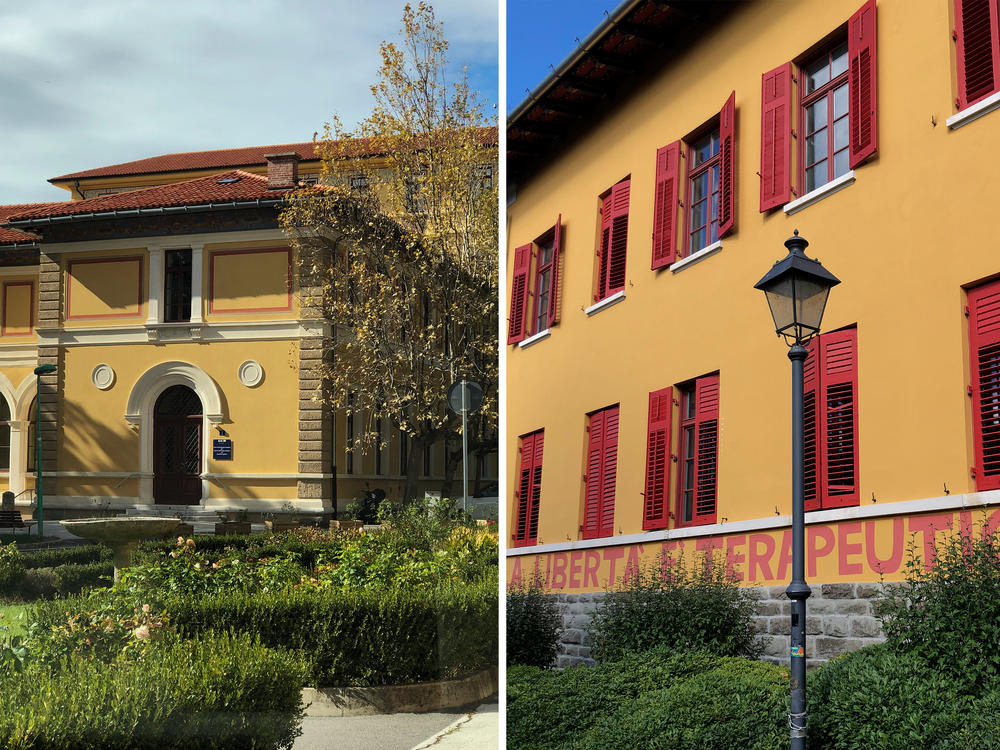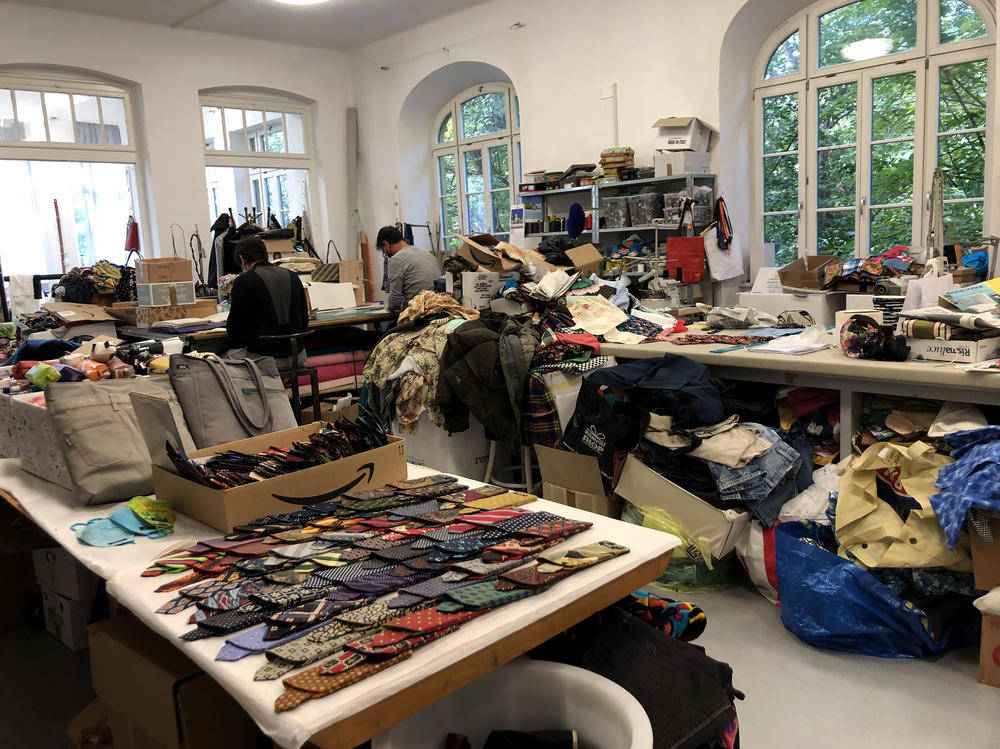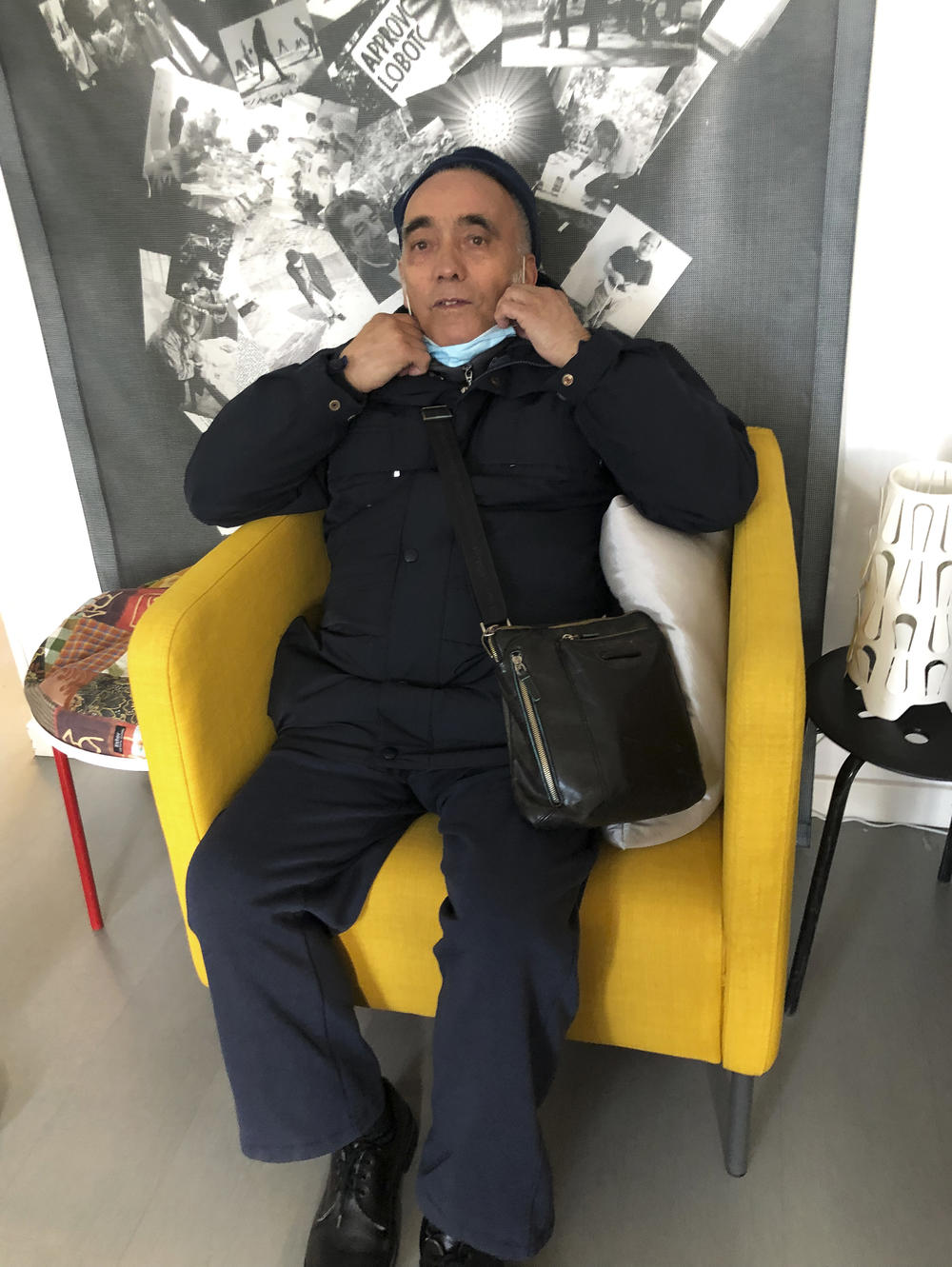Section Branding
Header Content
A public mental health model in Italy earns global praise. Now it faces its demise
Primary Content
Updated November 24, 2021 at 9:31 AM ET
TRIESTE, Italy — An old mental hospital sits in Trieste's San Giovanni Park alongside a large rose garden that stretches up a hill over the city. The facility closed over 40 years ago, but its ocher pavilions are filled with activity.
In one building, Radio Fragola (Strawberry Radio) broadcasts news and public services information. Next door is Il Posto delle Fragole (Strawberry Patch), a café and meeting point. (Their names are a nod to Ingmar Bergman's Wild Strawberries film.) Down the hall, workers are busy sewing ties, bags and clothing.
Helping staff these operations, as well as cafés, museums, libraries and other workplaces throughout the city, are people with mental illnesses who belong to a social cooperative called La Collina (the Hill).
This is all part of what's known as the Trieste model, an approach dating back to the 1960s that is recognized by the World Health Organization as one of the most advanced, community-based mental health care systems. Unlike in the past when psychiatric patients were confined in institutions where they faced abuse, the Trieste model set out to treat people with mental illnesses with dignity, including them in the community and in daily activities.
"Freedom is therapeutic," proclaims a slogan from the movement painted on a building of the old hospital.
But now, health experts decry that freedom is under assault. The region's right-wing leadership is beginning to break apart the publicly funded community system.
Patients were locked up
The old psychiatric hospital in Trieste used to forcibly confine people inside, according to Renzo Bonn, a psychiatrist and former director of mental health services in the nearby city of Udine.
"You [would] lose all your civil rights. You couldn't have the vote. You couldn't receive an inheritance. You couldn't get married," he says.
Some patients were locked in cages, tied in straitjackets and subjected to freezing water baths, electroshock and lobotomies.
If patients were not released within 30 days, confinement, Bonn says, could last indefinitely. "The result was the people once in the psychiatric hospital, all their life in psychiatric hospital," he says.
A mental health care revolution began
That all changed in the late 1960s with psychiatrist Franco Basaglia, who believed the old mental hospitals were used like dumping grounds for the poor and deviant.
"When patients are tied up, subjugated and held captive, I don't believe any kind of therapy can help them. I don't see a possible cure when there's no free communication between patient and doctor," he said in a 1969 TV interview.
Basaglia revolutionized the asylum: He knocked down walls, abolished the tying up of patients and encouraged them to take control of their lives.
Soon, not only were patients running a café on the grounds and earning wages at real jobs — they were holding hospital-wide patient assemblies.
When jazz came to Trieste
Pantxo Ramas, who is in charge of the hospital's archives, says it became a cultural hub — including a memorable 1974 concert for patients by an American jazz master. "And Ornette Coleman said this was the most deep free-jazz concert he did in all his life," Ramas says.
Shortly before the concert, Ramas recounts, a 50-year-old patient named Rosetta Lojacono walked onto the empty stage and started playing her harmonica. Coleman joined her and their jam session lasted more than an hour.
"He lost sense of who was a musician, who was an audience," Ramas says, "who was a doctor, who was an artist, who was a listener. And I think that's a moment of poetry. And I feel that this is a place full of poetry."
Interviewed later by one of the concert organizers, the saxophonist Coleman said, "I felt totally at ease, very normal. ... I liked that feeling, we were all free. ... Music can do that because sound is the science of feeling."
Italy abolished asylums, but there's a right-wing backlash
Basaglia's reforms ultimately led to a 1978 law that abolished all of Italy's mental asylums. He died in 1980, but his work continued and the Trieste model of community-based publicly funded mental health care has been emulated in several Italian regions and more than 40 countries, according to Roberto Mezzina, a former director of Trieste's mental health services.
But now, it's being dismantled by the Friuli-Venezia Giulia region's administration led by the hard-right Northern League and other right-wing parties.
Mezzina, now vice president of the World Federation for Mental Health, says for decades the goal of the region's right-wing politicians has been to put an end to the Trieste model and move toward privatization.
He says the model is "a symbol of something that was created in the area of social rights, human rights, and was considered part of the leftist culture."
In early October, the regional government announced plans to close seven of Friuli-Venezia Giulia's 22 community mental health centers and to reduce hours in remaining centers. It also plans to cut the number of senior psychiatrists and department heads, while keeping numerous staff positions unfilled.
The regional health authorities have not answered NPR's repeated requests for comment.
International health community is pushing back
Prominent international psychiatrists have signed petitions to save one of the world's premier public mental health services from being handed over to the private sector.
Allen Frances, professor and chair emeritus of psychiatry at Duke University, says instead of using coercion and medication as the solution to all problems, there's humanity and a community spirit behind the Trieste model.
"The community was primed to see the mentally ill not as a nuisance to be exiled to hospitals or in prisons and jails or left homeless on the street," says Frances, "but rather as potentially very useful citizens who deserve the attention and resources of the city and could make a meaningful contribution to it."
A patient recalls confinement and electroshock
One patient who experienced the mental health care revolution is 75-year-old Giordano Vascotto.
"I got here when I was 9, it was 1955, I remember the month, October," he says describing the Trieste mental hospital. "The windows were locked, doors were locked. Then they gave me electroshock. Many years passed."
After some 20 years of confinement, Vascotto was released.
"After the asylum, I rolled up my sleeves and went to work — first in a cemetery, then trash collector and doorman. Years passed, and now I'm retired," he says.
Like other patients, Vascotto can frequent mental health centers open 24/7
that are more like clubs that provide meals and where there's always a willing ear.
Mezzina, the former health official in Trieste, says that the city's rates of suicide, drug addiction, hospitalization and homelessness have been significantly reduced in the last 15 years.
But he stresses that the coronavirus pandemic has demonstrated the weakness
of privately owned hospitals — pointing to the many Italian elder care residences where the virus spread uncontrollably, triggering record numbers of deaths.
And the pandemic itself, he adds, has provoked a rise in psychiatric problems.
"Common mental disorders, anxiety and depression and post-traumatic stress. We have numbers that are doubling the number of young clients, for instance, in youth mental health, there is a huge increase," Mezzina says.
In an appeal written for the British medical journal The Lancet, Frances of Duke University says saving Trieste is not just a local Italian issue.
"When Trieste dies, it certainly kills the inspiration for other places to copy it," Frances tells NPR.
He also compares the situation to the United States, where he says the reduction of community services and hospital beds in past decades left a large number of mental illness patients homeless or incarcerated.
If Trieste fails to provide proper services for people with mental illnesses, he adds, it will end up paying more for police, emergency rooms and prisons.
Copyright 2021 NPR. To see more, visit https://www.npr.org.



